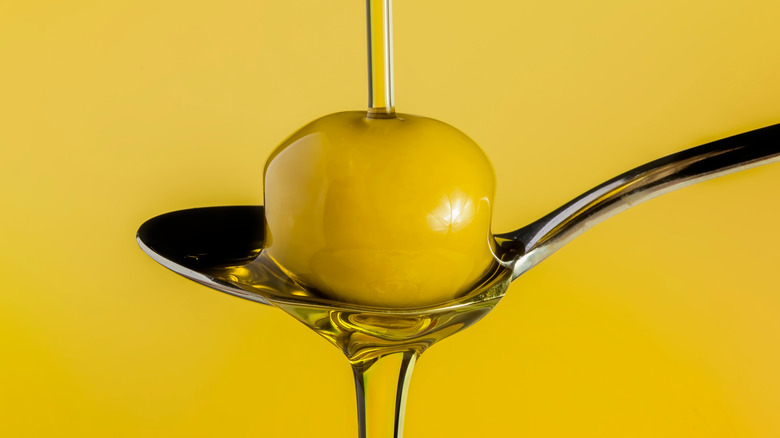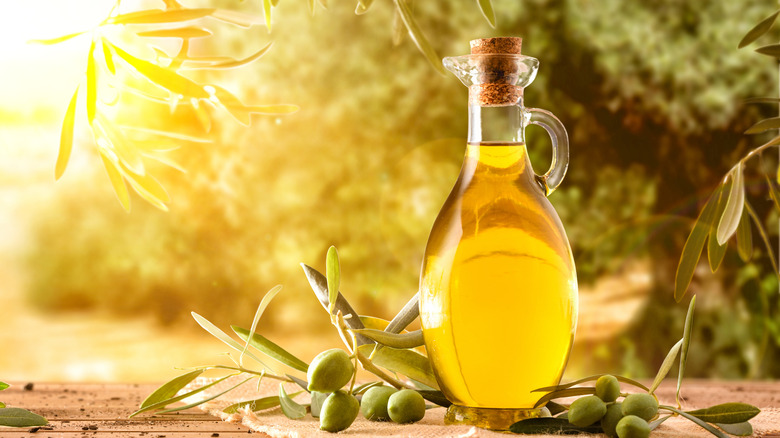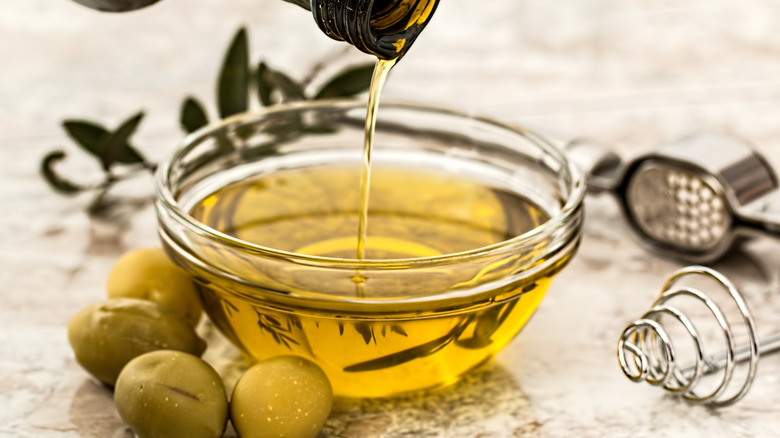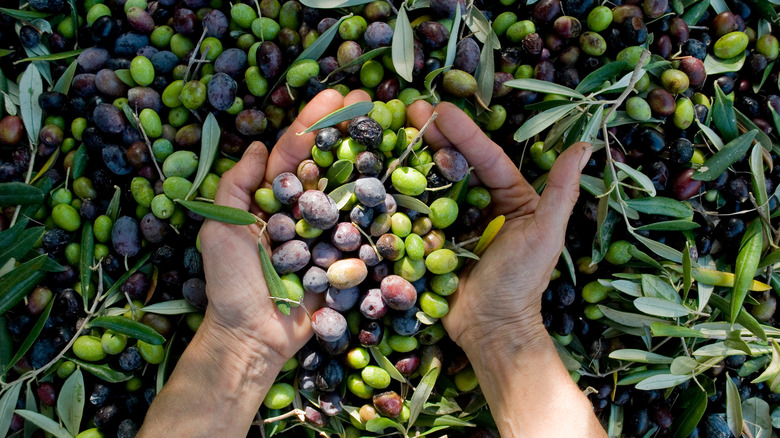How Chlorophyll Can Affect The Flavor Of Olive Oil
Perhaps the most ubiquitous cooking oil at present, olive oil — in all its iterations and complexities — is a fixture in millions upon millions of kitchens as we speak. Distinctive and celebrated within the Mediterranean diet and worldwide, olive oil is a prized ingredient for everyone from established chefs to novice home cooks. Its popularity stems from its health benefits, its fruity flavor, and its ease of purchasing. Tons of different variations of olive oil are sold at almost every supermarket or grocery store.
While the impetus for its popularity boon a few decades back is up for debate, the benefits of olive oil are hard to deny, from its grassy, distinctive flavor to its myriad health benefits. Masterclass certifies this point, noting that it "has a high content of monounsaturated fats ... and omega-9 fatty acids," labeling it "one of the healthiest cooking oils."
High-quality extra virgin olive oils are exceptional and an exercise in simplicity when paired with tomatoes, roasted peppers, and fresh mozzarella, or as a bare-bones salad dressing with some lemon and salt. Other olive oils are fantastic cooking oils that lend a subtle fruity flavor and provide the necessary lubrication and fat to properly cook various proteins and vegetables. Some olive oils are also beautiful in desserts, such as moist, spongy cakes or drizzled over grilled figs.
But what about its distinctive color? Is it true that a darker oil is better or perhaps even more nutritious?
What is chlorophyll?
As noted by Olive Oil Source, chlorophyll is one of olive oil's primary pigments, which "decreases as the fruit matures." Essentially, this means that the brighter colored an olive is, the more pungent its flavor would be, with "grassy" and fruity notes. Oxidation occurs when olive oil is exposed to the light, which can also change the color of the oil.
A study in Critical Reviews in Food Science and Nutrition states that chlorophylls "are responsible for the characteristic green color of the olive fruits and their products," as well as differentiating between virgin and extra virgin. Chlorophyll is essentially the green pigment that results in verdant plants, and it also contains "plenty of vitamins and antioxidants," according to Holar.
According to a study in Comprehensive Reviews in Food Science and Food Safety, the color of olive oil is the result of two pigments, chlorophylls and carotenoids. Of course, there's a direct correlation between the color or appearance of foods and how well they sell, as well as their general appearance in conjunction with how appetizing the item is. In some cases, the color is manipulated slightly by the producers in order to attain a specific ideal color. The study also notes that "there is no doubt that the crushing, milling, beating, health processes, ph-changes, and so on ... do favor the formation of chlorophyll derivatives," changing the inherent structure of the olive itself in order to produce a shelf-stable cooking oil.
Is darker olive oil better?
As Holar states, the subtleties of olive and olive oil coloring are also terroir-based, with certain differentiation in the soil, location, and climate having different results on the fruit.
Some olives oils are a dark green while others may have more of a dull yellow hue. It should be noted, though, that a dark oil does not signify a "better quality" oil by any means — just the presence of more chlorophyll than carotenoid. In addition, some have had chlorophyll artificially added, so while the darker color may be more appetizing and may even encourage more purchases due to the "darker oil is healthier" myth, it is sometimes just strictly aesthetic.
Of course, olive oil that has been sitting on the counter in a sunny spot for a year will not be of the highest quality anymore. Also, be mindful of the container the oil comes in, as it may also be tinted to help further the illusion of a "darker" oil. Darker bottles may be preferable in this case as opposed to anything transparent or tinted.
How to purchase and store olive oil
When it comes to purchasing olive oil, Rouxbe notes that top-quality olive oil is typically sold in dark tins or bottles, ideally to keep any ambient light way from the oil in order to best preserve the color and flavor.
Another great option is blending half olive oil and half neutral oil to help boost the smoke point, add flavor, and not use expensive olive oil exclusively. The Daily Meal does note, however, that "green oils tend to be higher in antioxidants and have a more intense peppery flavor with just a hint of bitterness." Still, this differs from producer to producer and is based on terroir. In actuality, more chlorophyll truly only results in a darker color with no legitimate differences in flavor or health benefits.
No matter how you're using olive oil, it's important to be mindful of the complexities and subtitles that make up the fascinating and well-loved ingredient. Next time you're shopping, don't be swindled into buying darker-colored oil under the assumption that it's automatically "better."



